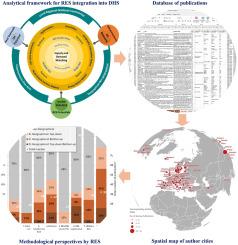A systematic approach to analyse methodologies for renewables-based district heating potential assessments – A categorisation and literature review
IF 5
Q2 ENERGY & FUELS
引用次数: 0
Abstract
District heating systems (DHS) serve as promising infrastructures to harness renewable energy for space heating and domestic hot water purposes. However, the manner in which the potential of renewable energy sources (RES) is assessed varies across sources. This study aims to synthesise knowledge on methodologies for evaluating the integration of various RES into DHS. Key aspects scrutinised in the methodologies include the dimensions addressed, the spatial approaches used, the tools and methods applied, and the overall process followed. A structured literature review process was conducted, reaching 260 documents for full-text review, encompassing scientific publications, national comprehensive assessments, and project reports. The focus has been put on six RES: heat sources for heat pumps (HPs), solar thermal, geothermal heat, biomass, power-2-heat (P2H), and surplus heat. The review highlights surplus heat as the most frequently studied source (35%). Moreover, it shows that from a technological point of view, HPs constitute an indispensable element in integrating most RES (except biomass), particularly in next-generation DHS where reduced supply temperatures enhance HP efficiency. From a methodological perspective, it is observed that spatial mapping is increasingly utilised to deal with the dispersed nature of heat sources and demands. The findings also accentuate the necessity of sector coupling to provide a holistic analysis, given either the inherent interlinkages between the DH sector and others (e.g., in P2H), the derivation of heat from other sectors (e.g., surplus heat), or the multifunctionality of certain heat sources (e.g., geothermal and biomass).

基于可再生能源的区域供热潜力评估的系统分析方法-分类和文献综述
区域供热系统(DHS)是利用可再生能源用于空间供暖和家庭热水的有前途的基础设施。然而,评估可再生能源(RES)潜力的方式因来源而异。本研究旨在综合评估各种RES整合到DHS的方法方面的知识。方法中审查的关键方面包括处理的维度,使用的空间方法,应用的工具和方法,以及遵循的整体过程。进行了结构化的文献综述过程,共计260份文献进行全文综述,包括科学出版物、国家综合评估和项目报告。重点是六种可再生能源:热泵(HPs)的热源,太阳能热,地热,生物质,动力-2-热(P2H)和余热。该综述强调,余热是最常被研究的来源(35%)。此外,从技术角度来看,HP是整合大多数可再生能源(除了生物质)不可或缺的元素,特别是在下一代DHS中,降低供应温度可以提高HP效率。从方法论的角度来看,空间测绘越来越多地用于处理热源和需求的分散性。研究结果还强调了部门耦合提供整体分析的必要性,考虑到卫生部门和其他部门之间的内在联系(例如,在P2H中),来自其他部门的热量的衍生(例如,余热),或某些热源的多功能性(例如,地热和生物质)。
本文章由计算机程序翻译,如有差异,请以英文原文为准。
求助全文
约1分钟内获得全文
求助全文

 求助内容:
求助内容: 应助结果提醒方式:
应助结果提醒方式:


